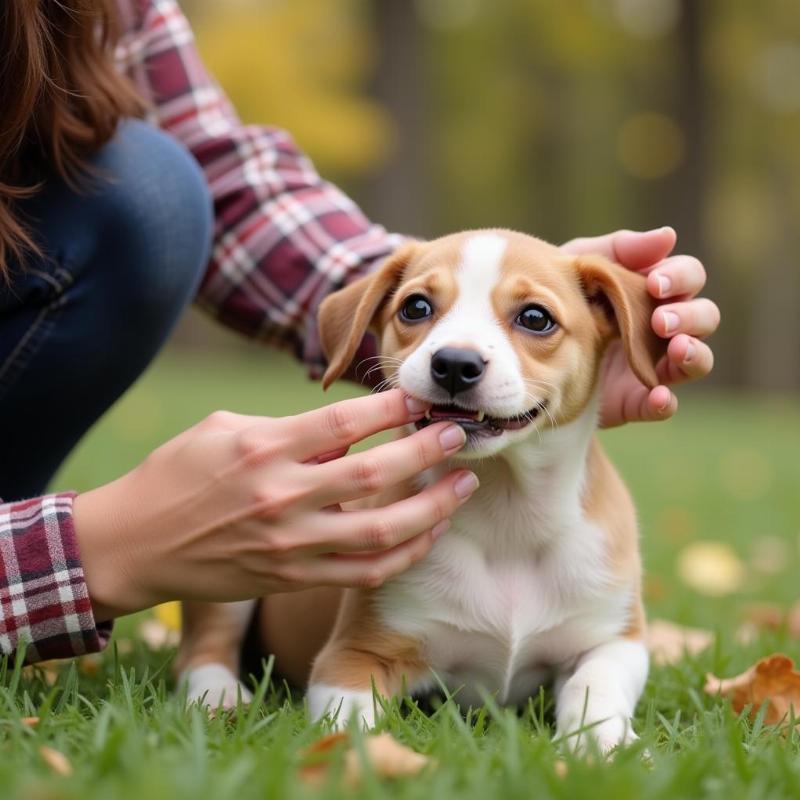When your playful puppy bounces around your older dog, it’s adorable, right? But sometimes that adorable play can escalate into roughhousing that leaves you wondering if it’s all in good fun. Understanding the dynamics of puppy rough play with older dogs is crucial for ensuring a harmonious multi-dog household. This article will help you decipher dog play signals, identify potential problems, and establish a safe and enjoyable environment for both your furry friends.
Decoding Canine Play: Is it All Fun and Games?
Puppies, bursting with energy, explore the world through play. This often involves nipping, chasing, and wrestling, behaviors that can be overwhelming for a more sedate older dog. Recognizing the signs of appropriate play versus aggression is paramount. Playful dogs exhibit loose body language, often bowing with their front end low and rear end high, a posture known as the “play bow.” They might playfully “mouth” each other, but their bites are inhibited, meaning they don’t use full force. Regular breaks in the action, where the dogs take a moment to shake off or re-engage, are another indication of healthy play.
When Play Gets Too Rough: Recognizing the Warning Signs
While some roughhousing is normal, it’s important to intervene if the play becomes too intense or one-sided. An older dog might tolerate a puppy’s exuberance for a while, but they’ll communicate their discomfort if it becomes too much. Look for signs like flattened ears, tucked tails, lip curling, whale eyes (showing the whites of their eyes), and low growls. These are clear signals that the older dog is stressed and wants the interaction to stop. Ignoring these cues can lead to escalated aggression and potential injury.
Setting the Stage for Harmonious Play: Tips for Success
Creating a positive play environment is crucial for multi-dog households. Provide separate spaces for each dog to retreat to when they need a break. Ensure both dogs have access to their own toys and resources to avoid resource guarding. Supervise play sessions, especially initially, and be ready to intervene if necessary. Short, frequent play sessions are better than long, unstructured ones. This helps prevent the older dog from becoming overwhelmed and allows the puppy to burn off energy in manageable bursts.
Teaching Bite Inhibition: A Crucial Skill for Puppies
Teaching your puppy bite inhibition is one of the most important aspects of socializing them with an older dog. When the puppy bites too hard during play, the older dog might yelp loudly. This is a natural correction and teaches the puppy to be gentler. You can also reinforce this behavior by stopping play immediately if the puppy bites too hard. This teaches them that rough play ends when they’re too rough.
 Owner Training Puppy Bite Inhibition
Owner Training Puppy Bite Inhibition
Is Your Older Dog Playing or Bullying?
Sometimes, an older dog might engage in behaviors that appear playful but are actually subtle forms of bullying. This can include pinning the puppy down repeatedly, relentless chasing without allowing the puppy to escape, or constant nipping that causes the puppy distress. If you observe these behaviors, it’s important to intervene and redirect the older dog. Consult with a certified professional dog trainer or behaviorist for guidance on addressing these issues.
Conclusion
Managing puppy rough play with an older dog requires careful observation, understanding canine communication, and proactive intervention. By recognizing the signs of healthy play versus stress, teaching bite inhibition, and creating a positive play environment, you can foster a harmonious relationship between your furry family members. Ensuring both your puppy and older dog feel safe and respected is essential for a happy home.
FAQ
-
How do I know if my older dog is enjoying playing with the puppy? Look for relaxed body language, play bows, and reciprocal engagement. If the older dog is stiff, avoids eye contact, or shows signs of stress, they likely aren’t enjoying the interaction.
-
What should I do if my older dog growls at the puppy? Don’t punish the growl. It’s a communication signal. Separate the dogs immediately and give the older dog a break. Reintroduce them later for shorter, supervised play sessions.
-
My puppy keeps nipping my older dog. What can I do? Teach your puppy bite inhibition. When they nip too hard, yelp loudly and stop play. Redirect them to a chew toy.
-
Is it normal for an older dog to correct a puppy’s behavior? Yes, older dogs often correct puppies, teaching them appropriate social skills. However, ensure the correction isn’t overly aggressive.
-
When should I seek professional help for dog play issues? If you’re concerned about the intensity of the play, the older dog’s reactions, or if any aggression is displayed, consult a certified dog trainer or behaviorist.
-
How can I create a safe play environment for my dogs? Provide separate resting areas, ensure access to their own resources, and supervise play sessions.
-
What are some signs that the play is too rough? Look for flattened ears, tucked tails, lip curling, whale eyes, growling, and yelping.
Related Articles on Beautdogs.us (None Found)
Beautdogs.us is your premier source for all things dog-related in the USA. We offer expert advice on dog breeds, care, and products, providing a trusted resource for both new and experienced dog owners. Our goal is to empower you with the knowledge and tools you need to raise a happy, healthy, and beautiful dog. For more personalized support, please contact us at [email protected] or call us at +1 501-555-7529. Beautdogs.us is committed to helping you and your furry friend thrive!